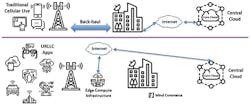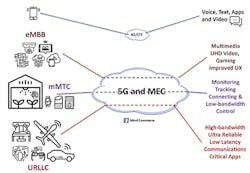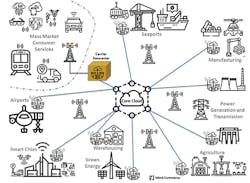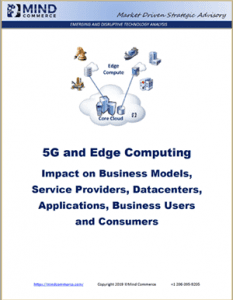What Will and Won’t Happen With Fifth Generation Cellular —
It’s hard to read anything in the media without seeing some reference or proclamation about how wonderful things are going to be with 5G for communications, applications, and services. At the same time, there is a vocal minority that is claiming there is nothing special about it, making statements such as "It’s just another ‘G’" or "We don’t need it" because LTE (e.g., the 4G technology) is good enough.
As is usually the case, the reality will be somewhere in between. The lofty claims about 5G are of course mostly hyperbole, because everyone wants to get excited about a new technology, and it’s human nature to reinforce your own belief about something, especially if you have committed massive sums of financial and social capital. After all, more than reputations are at stake as wireless carriers looking for ways to grow top line revenue.
The entire cellular ecosystem is making big bets that 5G will be a worthwhile investment. Carriers have spent billions on spectrum for 5G and even more on new radio access network (RAN) equipment as well as core network infrastructure to support advanced communications capabilities. Infrastructure vendors such as Ericsson and Nokia are rapidly gaining commitments from global network operators to launch 5G networks.
Leading technology vendors such as Qualcomm are placing bets that 5G will engender mass adoption of next-generation immersive technologies such as augmented reality (AR), virtual reality (VR), and mixed reality (e.g., combination of VR and "reality"). Collectively speaking, Qualcomm refers to AR, VR, and mixed as Extended Reality (XR), and is intimating towards a day in the not too distance future in which XR is an everyday occurrence for consumers.
Taking the aforementioned into consideration, we should realistically ask ourselves the following questions:
• Is 5G really special?
• Will it fundamentally change user experiences?
• Will it be worth the massive investment on the part of cellular network service providers?
The answer to the first question is yes, it is definitely special, and definitely not "just another ‘G’".
However, it is not a panacea either, and a good deal of the current rhetoric will not be realized in advanced consumer services, at least not right away. What will be a boon for 5G are enterprise and industrial networks including both public and private implementations?
Accordingly, carriers are highly advised to spend most of their efforts on solutions for business customers (e.g., enterprise, industrial, and government clients), even if it means losing some of their communications business due to private wireless deployment in which the business customer owns and operates a portion of their own internal network.
Three 5G Application Categories and Network Requirements
Before we go any further, it is important to understand what 5G is going to enable in terms of new capabilities. At the highest level, 5G is going to add value to three different categories of services (1) Enhanced Mobile Broadband, (2) Ultra Reliable Low Latency Communications, and (3) Massive Machine Type Communications. A descriptive of these categories is as follows:
1. Enhanced Mobile Broadband (eMBB): Mobile broadband-based apps will use MEC for more efficient operation. Localized processing will allow apps such as cloud-based gaming to run more smoothly and efficiently due to localized data caching and access to CDNs rather than routing all data through the network core. This will improve overall throughput, reduce latency, and minimize carrier resources needed to support data-hungry apps.
Arguably, the industry already has mobile broadband and Internet of Things (IoT) services through 4G and 3G respectively, the latter of which will be sunset with the implementation of 5G. It is a widely held opinion that LTE has provided dramatic improvements to mobile broad services such as video, adding fuel to the fire for those in the camp of "we don’t need 5G because we have LTE".
One of the arguments for Enhanced Mobile Broadband (eMBB) is that 5G will make networks more efficient at the core network level and that it will pave the way for greater data consumption (for example, even more video watching) and an improved user experience. End-users will be able to experience ultra-high definition video rather than just high definition video.
The question to ask here is: Will the investment in 5G justified by eMBB alone? Time will tell, but the logical answer is probably no, as 5G for mobile broadband seems to be more of the same, only faster and more efficient. The move from 4G to 5G is not likely to engender the same type of consumer response as the jump from 3G to 4G did in terms of mass adoption of mobile video.
Many smartphone-based apps simply did not function properly with the third generation cellular, but work quite well with 4G, especially with LTE Advanced version of the 4G standard. There will certainly be greater data usage on a per-customer basis, but the phase of massive data user penetration is now past. Now it’s all about how much (more) date users will consume and whether or not carriers can monetize their networks in ways other than upselling data plans.
2. Ultra-Reliable Low-latency Communications (URLLC): MEC will be particularly important in support of latency-sensitive apps and services for various consumer, enterprise, and industrial use cases. The combination of 5G and MEC is expected to reduce network latency significantly, which will enable many previously tethered-only applications and services such as VR, UAV control, autonomous vehicles, real-time remote control, haptic or tactile communications, and more.
The Extended Reality (XR) application area mentioned earlier is a good example. One of the ultimate goals of XR is for it to be indistinguishable from "reality". While this may be achievable in some respects with a wired connection (most likely fiber), it is not possible in an untethered (e.g. wireless) environment in a portable or mobile manner without 5G and beyond.
In fact, there is much more to consider than just the radio portion of 5G as both the RAN and core network must be updated in carrier networks to ensure latency of 1 to 5 milliseconds is realized. Furthermore, supporting equipment such as edge computing infrastructure must also be deployed to ensure that latency reduction achieved through 5G is not lost due to hub-and-spoke type network configurations.
Figure 1. Centralized Cloud Computing vs. Edge Computing
Traditional network topologies, such as the one depicted in Figure 1, require transport of all data packets through core network infrastructure to the Internet and/or back-haul to centralized cloud computing resources. In contrast, edge computing enables routing of data more directly, which will significantly reduce latency.
Often used synonymously, MEC refers to Mobile Edge Computing or Multi Access Edge Computing with the former being more cellular network centric (LTE and 5G) and the latter terminology adopted by standards groups to generalize edge computing to reflect that it may be also be used by WiFi and other wireless access technologies.
In cellular networks, edge computing via MEC is beneficial for LTE, but completely essential for 5G. This is because MEC facilitates optimization of 5G resources including focusing communications and computational capacity where it is needed the most. Mind Commerce research findings indicate a strong relationship between edge computing and 5G. In fact, if it were not for MEC, 5G would continue to rely upon back-haul to centralized cloud resource for storage and computing, diminishing much of the otherwise positive impact of latency reduction enabled by 5G.
In addition to supporting eMBB and URLLC applications and services, MEC also supports distributed computing needs for IoT networks. In fact, MEC will facilitate an entirely new class of low-power devices for IoT networks and systems. These devices will rely upon MEC equipment for processing. Stated differently, some IoT devices will be very light-weight computationally speaking, relying upon edge computing nodes for most of their computing needs.
InvisiLight® Solution for Deploying Fiber
April 2, 2022Go to Market Faster. Speed up Network Deployment
April 2, 2022Episode 10: Fiber Optic Closure Specs Explained…
April 1, 2022Food for Thought from Our 2022 ICT Visionaries
April 1, 2022Taken together, 5G and MEC provide the resources necessary for massive expansion of machine-type communications, which is the impetus for the acronym coined mMTC that refers to dramatic scalability and scope of IoT network deployment. In other words, cellular service providers are anticipated to compete with much improved scale (due to 5G support of IoT) than they could previously with 3G and LTE alone. 5G and MEC deployment will allow wireless carriers to be in a more favorably competitive position with providers of proprietary low power wide area network wireless solutions for IoT networks.
Figure 2 depicts the use of 5G and MEC to support the varying needs of different application categories. Compared to LTE network supported apps, 5G must juggle multiple requirements across different application categories. In some cases, these requirements are in conflict with one another, such as the need for high capacity and reliability, which is difficult to provide simultaneously.
Figure 2. 5G and Edge Computing Juggle Multiple App Requirements
3. Massive Machine-type Communications (mMTC): MEC will facilitate an entirely new class of low-power devices that rely upon MEC equipment for processing. Stated differently, some IoT devices will be very light-weight computationally speaking, relying upon edge computing nodes for most of their computation needs.
The network requirements for eMBB are largely mobility and high bandwidth, but not ultra-reliability. In contrast, URLLC apps such as those that may be found in public safety and commercial critical communications will require ultra-low latency and reliability as well as ample capacity.
On the other hand, mMTC applications will be largely low-bandwidth in nature, but depending on the solution, may require the high reliability of 5G as compared to WiFi. An example could be a critical industrial asset that must be monitored with assured periodicity to ensure operational efficiency, asset protection, and safety assurance.
Given the aforementioned capabilities coming with 5G and supporting edge computing technologies, what will the impact be on the application and services market? Mind Commerce sees the impact as moderate, considerable, and substantial, for consumer, enterprise, and industrial market segments respectively.
Moderate Impact on Consumer Applications and Services
In the near term, the 5G applications market is not anticipated to consist of a substantial amount of new consumer apps and services as compared to LTE. Instead, there will be mainly extensions to existing services such as much faster portable hotspots, improved browsing, and video viewing. There will also be some cannibalization of fixed network offerings due to 5G fixed wireless access for business, and to a lesser extent, as a consumer ISP alternative.
Longer term, Mind Commerce sees 5G acting as a launch pad for enhanced consumer wireless services such as augmented reality, virtual reality, and cloud gaming. However, we see mass adoption of mobile immersive technology application usage occurring only after the introduction of 6G technology, which is discussed later in this article.
Mind Commerce does not have a vision of personal drones following people all the time or people walking around everywhere with VR goggles. However, we do see AR, VR, cloud gaming, personal UAV, connected vehicles, and other consumer enhanced broadband services, growing over time in a manner that solidifies cellular service providers within the wireless ecosystem as the go-to data pipe for consumer apps, especially outside the home and on-the-go.
Considerable Impact on Enterprise Applications and Services
5G is poised to transform communications, applications, commerce, and content as it will provide substantially greater capacity and significantly reduced latency. Certain enterprise market applications and services are poised to benefit the most from this development. Mind Commerce sees many of these apps relating to smart buildings and the overall smart workplace.
Improving the operational effectiveness and efficiency, safeguarding assets, and establishing new value-added services are a few of the fundamental goals of smart buildings. In addition, intelligent use of ICT solutions are the key to continuous improvements in the areas of process automation and improved work flows for enterprise building assets ranging from office buildings to warehouses and other facilities.
While closely tied to smart buildings, it is important to note that the Smart Workplace is not tied to only to a building space as remote work includes home workers, telecommuting, and work while traveling. Accordingly, a larger definition of the Smart Workplace includes technologies and solutions to enable more efficient and effective workflow and other business operation considerations.
One of the most important things that 5G will bring to enterprise is an alternative to fixed network access for broadband. Mind Commerce sees 5G as a viable fixed wireless option for enterprise for a variety of purposes including inter-building communications and access to the Internet as a whole for everything from cloud computing and data back-up to logistics, asset tracking, telematics, and more.
Smart Buildings and intelligent work environments are arguably part of an even bigger opportunity for enterprise in terms of Smart Cities, which encompass virtually all aspects of work and play. Smart Cities are a focal point for growth drivers in several key ICT areas including: M2M/IoT, connected devices, broadband wireless, cloud computing, big data, and analytics. Smart City developments are causing solution providers to take a much more integrated approach to the design and operation of infrastructure and service capabilities.
Substantial Impact on Industrial Applications and Services
It is anticipated that 5G will have the biggest impact within the industrial sector as it will support new methods of untethered operation and new technologies, such as teleoperation, which represents the ability to operate equipment or a machine from a distance. A specific form of teleoperation involving remote control of a robot is referred to as tele-robotics. Teleoperation and tele-robotics are both supported by ICT infrastructure including broadband communications, sensors, M2M communications, and various IoT technologies.
Enhancements in wireless broadband are untethering teleoperation. Prior to 5G and advancement of the mobile edge computing market, teleoperation is largely relegated to fixed communications connections. 5G and edge computing together will enable teleoperation anywhere there is 5G coverage, enabling many new industrial automation scenarios involving robotics.
A specialize instance of tele-robotics known as cloud robotics is distinguished from the general field of electromechanical automation through its use of teleoperation as well as reliance upon various cloud computational technologies such as computing and storage as well as the emerging cloud-based business models enabling robotics as a service. Mind Commerce sees cloud robotics benefitting greatly from edge computing technologies as well as commercial introduction of 5G.
A related technology, digital twinning, refers to mapping the physical world to the digital world in which IoT platforms and software are leveraged to create a digital representation of physical object or asset. The digital twin of a physical object can provide information about the asset such as its physical state and disposition. Accordingly, digital twins represent a form of physical-to-cyber convergence.
Digital twin technology represents software that replicates physical machines enabling remote control and operation. Digital twinning enables a cyber object to replicate a real thing in both form and function, allowing control of real things (e.g., things in the real world such as a piece of equipment) by manipulating digital objects in a software-constructed world.
In summary, 5G will provide the communications and bandwidth necessary to allow various industries to leverage the next phase of automation and the evolution of robotics. Industrial users will capitalize upon new and enhanced 5G-enabled robotics capabilities to enable new use cases and improved work flow. Many business processes will change as the industrial segment becomes savvier about the flexibility of robotics uninhibited by location and bandwidth constraints.
Enterprise and Industrial Customers Choose Private Wireless Networks
Not to be confused with Citizens’ Band radio service used by truckers for two-way voice communications and that lives in the 27 MHz spectrum band in the United States, Citizens Broadband Radio Service (CBRS) represents spectrum in the 3.5 GHz band that has been opened up by the FCC for commercial use.
Why is this important? CBRS-based solutions may be used by various third parties to provide private wireless service. In some cases, the carrier’s own vendors are competing with them as service provider as has been the case with Nokia. However, there are others such as Ericsson who has said they will not compete with their own customers. Previously used for private LTE installations, the CBRS Alliance announced that it’s starting work on a new release to support CBRS over 5G.
There will be profound effects for networks, apps, and services, regardless of whether 5G is deployed in support of a private, public, or hybrid network. Carriers are working diligently to determine how they will work with enterprise and industrial business customers that install private networks. Leading communications service providers are focused on providing edge computing as a means of tying together enterprise private networks. This can be a good strategy as carriers struggle to identify their role in light of CBRS and other forms of unlicensed spectrum implementations for private LTE and 5G networks.
For business and government users, there is the option to utilize edge computing, LTE and 5G infrastructure from incumbent carriers, or to use enterprise-owned equipment, or a combination of both. In concert with large enterprise customers pursuing private wireless solutions, government users will likewise seek their own infrastructure for instances in which they see the need for improved oversight and control via on-site deployment.
Figure 3. 5G in Public and Private Networks
As depicted in Figure 3, the trend towards private wireless networks for enterprise and industrial customers means that these business clients will need to deploy their own 5G and edge computing infrastructure. This is already happening globally, wherein carriers are placing edge computing and LTE infrastructure alongside their communications equipment (such as an eNodeB or gNodeB in 5G implementations). In this approach, servers are placed within the carrier’s "telco closet" — often simply a caged-in area within the business customer’s own data center.
Almost all private networks require at least a portion to be indoor wireless. Implementations are often partially outdoor, indoor, and sometimes in a multi-building campus environment. This causes complexity, especially since 5G does not penetrate buildings well due to high attenuation of higher millimeter wave radio frequencies. However, indoor 5G is an option, accentuated by the fact that there are some IoT applications emerging for which WiFi is not reliable enough, such as a device that wakes up briefly to send a signal that may be very important, like boiler pressure.
Private wireless deployments will leverage both licensed and unlicensed cellular spectrum as well as WiFi and other wireless access in the local area. While the 5G applications market will not rely upon WiFi for certain mission-critical industrial functions, WiFi will persist in an enterprise and government facilities, sharing edge computing resources — hence the designation multi access fits for the MEC acronym for wireless edge computing.
What to Expect With 5G?
5G Radio Access Network
In terms of the RAN portion of 5G, mmWave radio frequencies attenuate considerably as compared to LTE, necessitating the need for at least ten times more antennas than 4G technologies require. In addition, 5G will require 5G Smart Antennas to optimize coverage, mobility, and minimize the need for hand-over from 5G to 4G RAN. Accordingly, the 5G applications market will be dependent upon Smart Antennas that use Multiple Input / Multiple Output (MIMO) at both the source (transmitter) and the destination (receiver) to improve signal quality.
Once 5G networks are operational, continuous coverage will be facilitated by directing RF where it is needed communications. In absence of Vo5G coverage, calls will need to hand-over to LTE, analogous to how LTE handover to 3G was accounted for in 4G deployments. However, there is a big difference. Unlike LTE, which is becoming increasingly ubiquitous (especially in metro areas), 5G will be more constrained and thus is in need of Smart Antennas to direct RF signals to optimize quality of experience.
While 5G deployment is leveraging some new frequency bands and will entail a 10 to 100 times expansion of number of cells, much of it will NOT be mmWave. Instead, a big part of the 5G applications market is driven by the evolution of 4G/LTE (Long Term Evolution standard). In fact, technology improvements for LTE are ongoing as it will continue to be relied upon for many applications and services for a long time. Accordingly, vendors will continue to optimize LTE capabilities such as improved uplink capacity to support video and wireless communication to cloud-based applications. LTE adoption will continue at a fast pace with many innovations overlapping with 5G operations.
Early 5G implementations are focused primarily on the RAN portion of networks. Accordingly, the industry is witnessing some impressive gains in bandwidth, but not yet realizing the latency gains possible with 5G. This is because there is a need to implement mobile edge computing alongside 5G, which is going to be a multi-year process. In addition, an interim step will be to update mobile network operate core networks to be able support improved throughput and reduced latency.
Inside buildings, WiFi will continue to be important, especially since 5G has penetration issues. However, it is important to note that this applies mainly to the consumer and SMB market. For business customers, indoor wireless solutions will be comprised of 5G and WiFi.
5G Applications, Services, and Network Challenges
Based on many years of research coverage into LTE and 5G technology and solutions, Mind Commerce has gained valuable insights that have informed our opinions about 5G applications and services. For example, the report, LTE and 5G Applications and Services Market by Service Provider Type (MNO, OTT, End-user), Connection Type, Deployment Type (Public and Private Virtualized, Dedicated, and Hybrid), Use Cases, 5G Service Category (eMBB, mMTC, URLLC), Computing as a Service (Public, Private, Hybrid), Industry Verticals, Region and Country 2019 – 2024, Mind Commerce has identified opportunities for the 5GNR market in private wireless for industrial automation will reach $3.1B by 2024.
5G Consumer Applications
The 5G applications market will benefit from much improved general mobile broadband communications for things that consumers do today — mostly video-oriented if one is measuring usage on a data consumption basis. Expectations will transition from high-definition to ultra-high-definition video. We already have high-definition voice, but Voice over 5G (Vo5G) will leverage core network infrastructure to provide an improved voice/audio experience in terms of integration with many next-generation applications such as 5G-based VR.
Despite the industry emphasis on many new data-related capabilities materializing with 5G, voice will remain a critical function, but will diminish in importance as a stand-alone service. While 5G will support Ultra High Definition (UHD) audio communications, streaming video and ultra-clear voice communication are not anticipated to be the most important overall economic impacts of the technology.
Instead, the main value proposition will be Vo5G embedded with many advanced applications and services, including Unified Communications, Real-time Communications (including WebRTC), Telepresence, AR, VR, and Mixed Reality, tele-robotics control, and various IoT-enabled applications and services. Vo5G will also replace VoLTE as a preferred method of vocal/auditory communication as well as act as the input medium for a wide variety of user interfaces, many of which currently rely upon WiFi.
Overall, consumer 5G apps and services will take longer to develop positive ROIs than will business apps.
5G Business Applications
5G will make IoT scalable. Currently, IoT relies upon many proprietary, non-cellular means for WAN communications. With the introduction of 5G support for "Massive IoT" via the Machine Communications support capabilities, M2M networking will able to become virtually as large as it needs to be for a given enterprise, network, system, etc. Stated differently, there will be the ability for many more low-power IoT devices with extreme coverage within a metropolitan area.
IoT solutions will benefit greatly from the implementation of 5G as cellular providers deploy Low Power WAN (LPWAN) IoT network capabilities. Initial deployments of IoT LPWANs have been non-cellular solutions based on proprietary technologies. However, Mind Commerce sees emerging standards such as Narrowband IoT (NB-IoT) assuming a dominant role for certain IoT applications. We see many industry verticals willing to pay a premium over non-cellular LPWAN, enhanced flexibility, and improved capabilities associated with M2M communications for IoT on 5G networks.
The 5G applications market as a whole is going focus upon enterprise, industrial, and government, sectors with an emphasis solutions rather than individual apps or services. Many of these solutions will require ultra-reliable, low-latency capabilities for industrial automation.
Manufacturing, industrial automation, and robotics, are key sectors that will also benefit substantially. Prior to 5G, teleoperation is largely relegated to fixed communications connections. The 5G applications market within the industrial vertical will support teleoperation anywhere there is 5G coverage. This will enable many new automation scenarios involving robotics.
Some 5G business customers will go with private networks for their own facilities. Some of those private networks are going to be in competition with the carriers as the likes of Nokia are actually competing with their own customer (e.g., carriers) by providing them.
5G Data and Data-as-a-Service
MEC-supported 5G networks will generate massive amounts of data. In some cases, data may be passed as a real-time stream to enterprise organizations for real-time decision-making. In addition to conventional data analytics software, systems may be augmented with AI to provide further data management efficiencies as well as improved decision-making effectiveness.
In many cases, the data itself and actionable information, will be the product, often delivered in a Data as a Service (DaaS) market model. As the industrial IoT market in particular evolves, there will an increasingly large amount of unstructured machine data. This rapidly growing amount of machine generated industrial data will drive substantial opportunities for AI support of unstructured data analytics solutions.
Service providers must balance the need to determine what data may be processed at the edge (with potential real-time business implications) versus data that may be simply transmitted to a centralized cloud for storage and post-processing. The use of AI for decision-making in data analytics will be crucial for efficient and effective decision-making, especially in the area of streaming data and real-time analytics associated with MEC.
One of the key opportunities for DaaS is enterprise data syndication, which is the opportunity for companies of various sizes to syndicate (e.g., share and monetize) their data. This is one of the biggest opportunities for MEC infrastructure and service providers and the DaaS market as whole.
5G Network Impacts
Fifth Generation cellular networks are poised to provide 3 major benefits: (1) Enhanced mobile services, (2) Massively scalable IoT networks, and (3) Ultra-reliable and low-latency Communication for both mission-critical services (such as public safety and industrial automation) and latency-sensitive consumer services (such as virtual reality). A portion of these benefits will be based on the evolution of 4G LTE technologies as well as unique capabilities enabled by 5G New Radio (5GNR) based on new infrastructure supporting mmWave radio RAN equipment.
It is important to recognize the 5G build-out is a multi-year endeavor that will require significant investment for carrier core network infrastructure, such as IP Multimedia Subsystem (IMS) and distributed mini-datacenter, as well as RAN equipment.
5G will "reinvent" connectivity in so much as there will be a very credible alternative to cable and fiber for business customers. In addition, there will be competition even for WiFi as some critical communications will require 5G.
Accordingly, Mind Commerce sees growth of the aforementioned leading 5G applications and services tempered by carrier infrastructure deployment. This will be more the case for network operator’s 5G RAN equipment than for IMS as the former is problematic due to the need for many additional cell sites and specialized smart antenna capabilities such as MIMO and beamforming, which is the ability to intelligently direct RF signals where needed.
It is important to recognize that 5G is a huge investment and the near-term ROI is very focused on point solutions for enterprise, industrial, and government, customers that require alternatives to fiber and/or untethered broadband. As part of these solutions, 5G is important for the front-haul, mid-haul, and back-haul infrastructure market, collectively referred to as x-haul market. The transport networks that will be impacted by 5G x-haul include fiber, DWDM, and microwave, as well as switching/routing.
5G will bring about fundamental structural economic changes, such as significantly lower broadband pricing as a whole, and also much greater flexibility for enterprise, industrial, and government, market segments in terms of how they connect public to private networks.
On the supply side, the cost-per-bit will plummet with 5G. This is because 5G is both more efficient than its predecessors and encourages more competition to wired broadband solutions such as cable and fiber. Connectivity and transport cost structures will hasten their already downward trajectory as communication options increase substantially.
As with any supply and demand curve, the much greater supply (e.g., greater bandwidth availability at lower cost) translates into diminished end-user value perception. Most forms of telecommunications are highly elastic in economic terms, meaning that perceived value (and therefore pricing) of core services such as voice, text, and data, will begin to nose dive due to 5G supply-side dynamics.
On the demand side, consumer data usage will increase dramatically as expectations evolve to include ultra-high-definition video, realistic gaming, virtual reality, and other bandwidth-hogging, latency-dependent apps. Business and government users will similarly increase data usage exponentially, but they will demand a solutions-driven approach to solve use-case-specific problems.
5G Challenges With Multiple Requirements
Future use cases for the 5G applications market are many and varied in terms of type, industry vertical focus, and requirements. Correspondingly, each scenario will have its own network configuration of requirements and parameters.
Various 5G- and MEC-related throughput and latency improvements will facilitate adoption of latency-sensitive applications that rely upon Ultra Reliable Low Latency Communications (URLLC). Examples of URLLC dependent apps and services including UAV operation, autonomous vehicles, teleoperation, augmented and virtual reality, haptic communications, and other critical communications such as public safety apps.
However, 5G networks will be constrained to simultaneously support often mutually exclusive requirements such as high-capacity, low latency, and high reliability. Different application-use case scenarios will have their own requirements and associated network configuration needs.
5G network slicing provides a means by which each of these different use cases may have its own portion of available frequently and associated assignable QoS configuration. Carriers will update their OSS/BSS systems in terms of administration of slice allocations (including service level agreements) as well as billing for slices and usage. However, dividing network resources into "slices" will not be enough to deal the need for simultaneous capacity and reliability needs. This is one of the areas that must be addressed with Sixth Generation (6G) wireless.
What is next after 5G? You guessed it: 6G
Is it too early to think about 6G? In a word, no! Mind Commerce started looking beyond LTE in circa 2010/2011. We have recently concluded an investigation into 6G, and have developed some valuable insights, which may be found in our report Sixth Generation Cellular: Looking Beyond 5G to the 6G Technology Market.
The 6G technology market is anticipated to facilitate substantive improvements in many areas including various next-generation solutions such as wireless sensing, imaging, and presence and location determination. Higher frequencies will enable much faster sampling rates as well as significantly greater accuracy, down to the centimeter level for extremely accurate location determination.
Like this Article?
Subscribe to ISE magazine and start receiving your FREE monthly copy today!
This will have big implications for many government and industry solutions in public safety and critical asset protection such as threat detection, health monitoring, feature/facial recognition and decision-making (as in law enforcement, social credit systems, and other areas), air quality measurements, gas and toxicity sensing, and much more.
One of the realizations from our analysis is that 5G will be largely a bridge to 6G. That’s correct. As great as the improvements manifest by 5G will benefit the ICT industry, it will be largely just a stepping stone to Sixth Generation cellular. In other words, we believe that 10 years from now, people will consider 5G to be to 6G as 3G was to 4G.
In terms of ICT evolution that is anticipated over the next 10 years, Mind Commerce expects networks to become increasingly more adaptive and intent-based. Network operators have made great strides with existing technologies. However, AI in combination with Software-Defined Networking (SDN) and advanced analytics is poised to take autonomous, intelligent network operation and control to an entirely new level.
While AI has not yet made extensive inroads into the realm of networks, cellular systems in particular will soon achieve early and extensive success through the combination of Machine Learning, SDN, and advanced data analytics technologies.
Intent Based Networks (IBN) capture business intent, and in so doing, bridge the gap between business operations and information technology. The benefits of intent-based networking are many and varied, but arguably all improvements stem from the ability for IBN to automate network management and orchestration in a proactive and intelligent manner. Accordingly, intent based networking represents a solution set that is at the confluence of a few key technologies including machine learning (and other forms of AI), SDN, and IoT technologies.
These developments will be important for 5G (and 6G) networks as the use cases for future solutions are many and varied in terms of type, industry vertical focus, and requirements. Many of these use cases will involve IoT and be supported by AI algorithms. Therefore, the Artificial Intelligence of Things (AIoT) market will gain in concert with the 5G evolution to 6G technologies.
The role and importance of AI in 5G/6G includes optimizing resource allocation, data security, and protection of network and enterprise assets. Therefore, inclusion of AI with next-generation wireless networks will bring great benefits. However, the concept of using AI in networking is a relatively new area that will ultimately require a more unified approach to fully realize its great potential.
Need More?
Download This Complimentary Report!
5G and Edge Computing Impact on Business Models, Service Providers, Datacenters, Applications, Business Users and Consumers
Report Analyzes the Impact of 5G and Edge Computing
- The powerful combination of 5G and edge computing will transform business models, service providers, datacenters, applications, business users, and consumers.
- Combination of 5G and edge computing infrastructure will change the business relationship between carriers and their most valuable customers: enterprise, industrial, and government.














